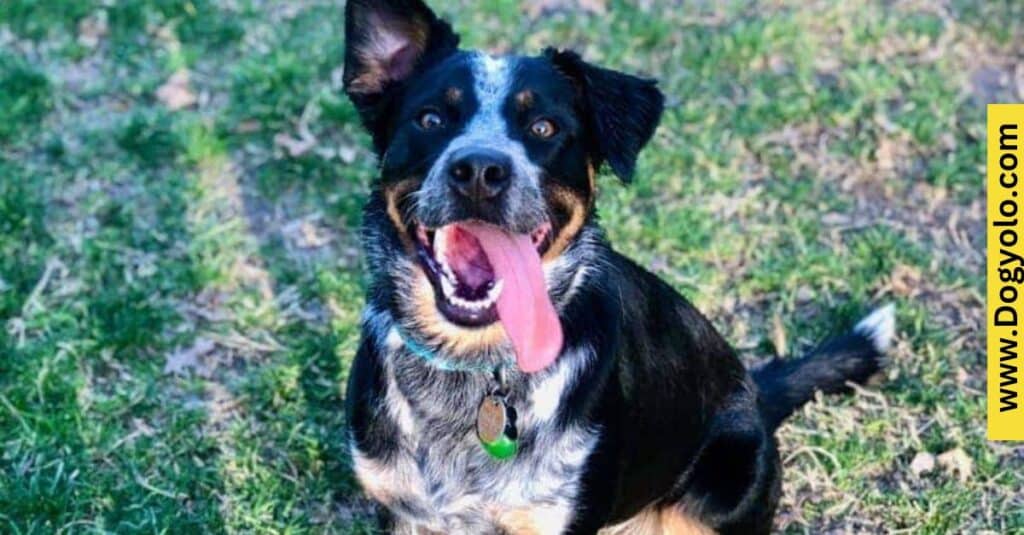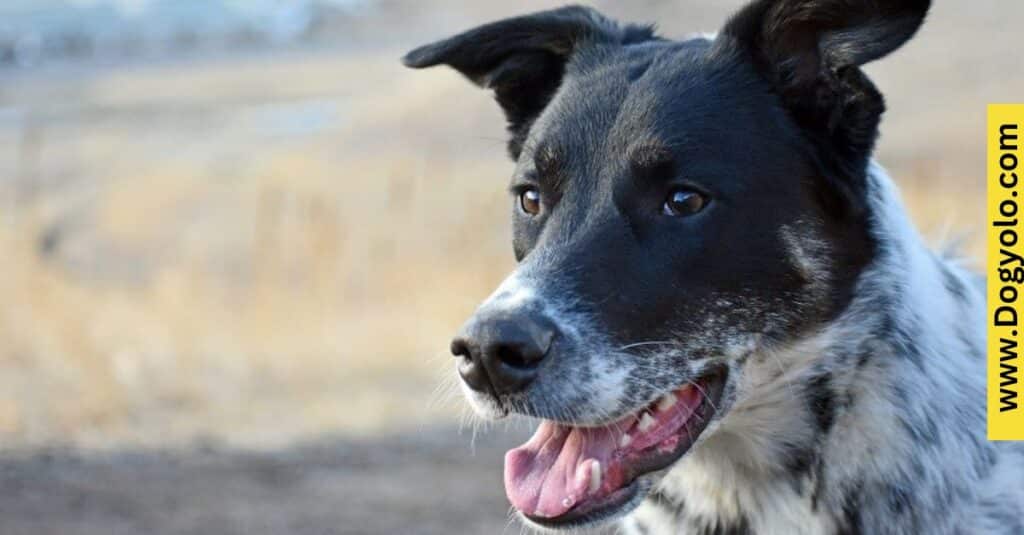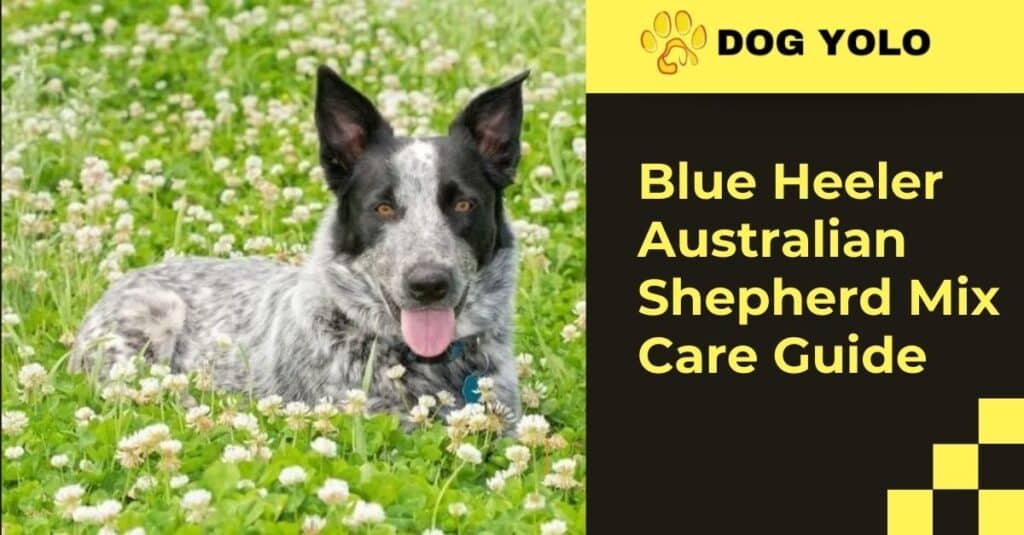If you’re looking for a high-energy, loyal, and intelligent companion, the Blue Heeler Australian Shepherd Mix might be the perfect dog for you.
This hybrid dog, often referred to as the Texas Heeler, combines the best traits from two of the most hard-working herding breeds—the Australian Cattle Dog (Blue Heeler) and the Australian Shepherd.
In this comprehensive care guide, you’ll learn everything you need to know about this unique crossbreed—from its physical traits and temperament to exercise needs, grooming, and health considerations.
Whether you’re considering bringing one into your home or already own one, this guide will help you provide the best care possible.
Origins of the Blue Heeler Australian Shepherd Mix
The Blue Heeler Australian Shepherd Mix is a crossbreed, resulting from the combination of the Australian Cattle Dog (commonly known as the Blue Heeler) and the Australian Shepherd.
These two breeds are known for their exceptional herding abilities and were originally bred to work on farms and ranches.
- Blue Heeler (Australian Cattle Dog): Originating in Australia, the Blue Heeler was bred to herd cattle across rough terrain. This breed is incredibly hardy, with a high level of stamina and a strong work ethic.
- Australian Shepherd: Despite its name, the Australian Shepherd was actually developed in the United States. Known for its intelligence and agility, this breed excels in tasks such as herding, agility competitions, and even working as service dogs.
When combined, the Blue Heeler Australian Shepherd Mix inherits traits from both parent breeds, creating a designer breed that is both energetic and loyal, making it a popular choice for those who lead active lifestyles.
Read more about 25 Chow Chow Mixes
Physical Characteristics of the Blue Heeler Australian Shepherd Mix

The physical traits of the Blue Heeler Australian Shepherd Mix are a blend of both parent breeds. While each dog can vary in appearance depending on the genes they inherit, some common characteristics can be observed across the breed.
Coat Type and Colors
- Coat Texture: Typically, these dogs have a double coat with a soft undercoat and a weather-resistant outer coat, making them suitable for outdoor activities in various climates.
- Coat Colors: You’ll find a variety of coat colors, ranging from blue merle (common in Australian Shepherds) to the classic blue or red speckled coat of the Blue Heeler. Some dogs may also display white markings or tan points.
Read more about Cane Corso German Shepherd Mix
Body Type and Size
- Size: On average, the Blue Heeler Australian Shepherd Mix is a medium-sized dog, weighing between 35 to 50 pounds and standing 17 to 22 inches at the shoulder.
- Body Type: These dogs are muscular, with a strong, athletic build. They have broad chests, sturdy legs, and a slightly elongated body, built for endurance and speed.
| Trait | Description |
|---|---|
| Coat Type | Double coat, weather-resistant |
| Common Colors | Blue, red, merle, speckled |
| Size | Medium-sized (35-50 pounds) |
| Build | Muscular, athletic |
| Ears | Floppy or semi-erect |
| Tail | Typically long, sometimes docked |
Temperament and Personality Traits
The Blue Heeler Australian Shepherd Mix is known for its friendly temperament, intelligence, and high energy levels.
These dogs are a great choice for families who can meet their exercise needs and provide plenty of mental stimulation.
Key Temperament Traits
- Loyalty: This breed is fiercely loyal and will often form a strong bond with one or two primary caregivers. They can be protective, making them excellent watchdogs.
- Energetic: These dogs are always on the go. They need a lot of physical activity to stay happy and healthy.
- Intelligent: Both the Australian Shepherd and the Blue Heeler are known for their intelligence. This mix loves learning new tricks and tasks, excelling in training.
- Socialization: Early socialization is crucial for this breed. Without it, they can become overly protective or shy around strangers.
Fun Fact: The Blue Heeler Australian Shepherd Mix is often used as a guide dog or in other service dog roles due to their intelligence and trainability.
Read more about Miniature Husky
Family Compatibility
While they make excellent family pets, it’s essential to ensure these dogs get enough mental and physical stimulation.
Without proper outlets for their energy, they can become destructive or exhibit unwanted behaviors such as herding children or other pets.
Trainability and Behavioral Considerations

Training a Blue Heeler Australian Shepherd Mix is usually a breeze due to their intelligence and eagerness to please. However, their herding instincts can sometimes pose a challenge, especially with small children or animals.
Training Tips
- Positive Reinforcement: Always use positive reinforcement techniques. These dogs respond well to praise, treats, and playtime.
- Consistency is Key: Be consistent in your commands and training sessions. Short, frequent sessions work best.
- Socialization: Expose your dog to a variety of people, animals, and environments from a young age to prevent aggression or fear-based behaviors.
Common Behavioral Issues
- Nipping and Herding: Due to their strong herding instincts, they may nip at heels or attempt to “herd” people or other animals. Redirect this behavior with training and by providing tasks to fulfill their need to work.
- Separation Anxiety: This breed can become overly attached and develop separation anxiety if left alone for long periods.
Exercise and Activity Requirements
The exercise needs of a Blue Heeler Australian Shepherd Mix are high, and they thrive in homes that can provide them with an outlet for their abundant energy.
Daily Exercise Needs
- Minimum Activity: These dogs need at least 60-90 minutes of exercise each day. This can include walks, runs, playtime, or agility training.
- Agility Exercises: Many owners find success in enrolling their dog in agility training, which keeps them physically and mentally engaged.
- Outdoor Space: If possible, having a yard or outdoor area where your dog can run and play freely will help prevent behavioral issues caused by boredom.
Mental Stimulation
In addition to physical activity, this mix needs mental stimulation to stay happy. Puzzle toys, obedience training, and interactive play are great ways to keep their minds sharp.
Grooming and Maintenance
Proper grooming is essential for keeping the Blue Heeler Australian Shepherd Mix healthy and looking their best. While they are relatively low-maintenance compared to some breeds, they do require regular attention.
Coat Maintenance
- Brushing: Regular brushing (2-3 times a week) is necessary to keep their coat free from mats and tangles, especially during shedding seasons.
- Shedding: These dogs tend to shed moderately, with heavier shedding occurring in the spring and fall.
Bathing
- How Often to Bathe: Bathe your dog only when necessary (every 4-6 weeks), as over-bathing can strip the natural oils from their coat, leading to skin irritation.
Nail Trimming and Dental Care
- Nail Care: Trim your dog’s nails every 3-4 weeks to prevent overgrowth.
- Dental Hygiene: Brush your dog’s teeth regularly and provide dental chews to promote healthy gums and teeth.
Common Health Problems and Lifespan

Like all dog breeds, the Blue Heeler Australian Shepherd Mix is prone to certain health problems that owners should be aware of.
While generally healthy, early detection and preventative care can make a big difference in your dog’s lifespan.
Genetic Health Conditions
- Hip Dysplasia: A common condition in medium to large breeds, where the hip joint doesn’t develop properly.
- Deafness: This mix is sometimes prone to deafness, particularly if they inherit the merle coat pattern.
- Cataracts: Eye issues like cataracts can develop in older dogs, affecting their vision.
Regular Vet Visits
To keep your dog in the best possible health, regular vet check-ups are crucial. Ensure that vaccinations, heartworm prevention, and flea/tick treatments are kept up to date.
Lifespan
The average lifespan of the Blue Heeler Australian Shepherd Mix is 12-15 years, though with proper care, some dogs live even longer.
| Health Issue | Description |
|---|---|
| Hip Dysplasia | Improper development of the hip joint |
| Deafness | More common in merle-coated dogs |
| Cataracts | Eye issues, especially in older dogs |
| Lifespan | 12-15 years |
Is the Blue Heeler Australian Shepherd Mix Right for You?
The Blue Heeler Australian Shepherd Mix is best suited for active individuals or families who can meet their exercise and mental stimulation needs. If you lead a sedentary lifestyle, this breed may not be the right fit for you.
Pros
- Loyal and protective nature.
- Highly trainable and intelligent.
- Excellent family companion for active households.
Cons
- High exercise needs—requires at least 1-2 hours of activity daily.
- May nip or herd due to strong working instincts.
Conclusion
The Blue Heeler Australian Shepherd Mix is a wonderful, loyal, and energetic companion for those who can keep up with their exercise needs and provide them with the proper training and care.
If you’re looking for a dog that is not only intelligent but also fiercely devoted, this hybrid may be the perfect fit for you.
Before bringing one home, consider whether your lifestyle aligns with the needs of this active and hardworking dog. With proper care, training, and love, your Blue Heeler Australian Shepherd Mix will thrive as a valued member of your family.

Vala John is an experienced blogger at Dog Yolo, where she shares her deep passion for all things canine. With years of expertise in dog care, training, and lifestyle tips, Vala’s writing helps dog lovers build stronger bonds with their furry friends. Her insightful posts make her a trusted voice in the pet community, offering practical advice for dog owners of all levels.







